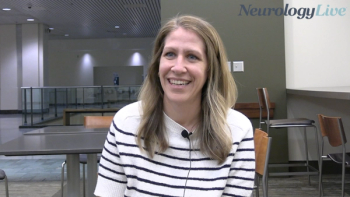
Corticosteroids Show Improvements, Lead to Remission in Patients with CIDP
Nine of 10 patients with chronic inflammatory demyelinating polyneuropathy may benefit from a regimen of pulsed corticosteroids followed by intravenous immunoglobulin.
Gwen van Lieverloo, PhD
The use of corticosteroids led to an improvement and, in some instances, remission, in patients with chronic inflammatory demyelinating polyneuropathy (CIDP), according to new study findings.
As noted by lead author Gwen van Lieverloo, PhD, from the Academic Medical Centre at the University of Amsterdam, in The Netherlands, and colleagues, despite their use in treating CIDP, the efficacy of corticosteroids in this area has been less than well-known. In order to assess a trio of therapies’ success, van Lieverloo and others explored the use of daily prednisolone, pulsed dexamethasone, and pulsed intravenous methylprednisolone in 125 patients.
The retrospective findings ultimately revealed that pulsed corticosteroids regimens have lower cumulative doses, and possibly less long-term adverse events (AEs), thus a protocol with corticosteroids, followed by intravenous immunoglobulin in case corticosteroid treatment is insufficient, can lead to improvement in roughly 90% of patients.
"Corticosteroids are a safe first-line treatment for CIDP with a response rate of 61% and a 33% probability to reach long-term remission," van Lieverloo told NeurologyLive. "We suggest a pulsed corticosteroid regimen with osteoporosis prophylaxes. "
In total, 54% (n = 67) of patients were assigned daily prednisone, 30% (n = 37) of patients were given pulsed dexamethasone, and 17% (n = 21) were administered pulsed intravenous methylprednisolone. Of those, 60% (n = 75) of patients responded to the corticosteroids, with no real differences between regimens (95% CI, 51 to 69; P = .56). The prednisolone group observed a rate of response of 57% (n = 38; 95% CI, 45 to 69), while the dexamethasone group observed a rate of 68% (n = 25; 95% CI, 52 to 83), and the methylprednisolone group observed a rate of 57% (n = 12; 95% CI, 34 to 80).
Ultimately, a response was seen in 3 of 12 patients (25%) with multifocal CIDP, or multifocal acquired demyelinating sensory and motor neuropathy.
The median duration of treatment was 15 months (range, 2 to 60), 6 months (range, 5 to 12), and 6.5 months (range, 1 to 60) for prednisolone, dexamethasone, and methylprednisolone, respectively, with the overall median being 6 months (range, 2 to 60). Prednisolone was administered in an estimated cumulative dose of 10,800 mg, compared to 6000 mg and 9375 mg with dexamethasone and methylprednisolone, respectively.
The difference, the authors explained, was due to the longer duration of treatment in this group, as well as the inclusion of “more severely affected patients, compared to the other two treatment regimens [Medical Research Council sum score P = .003 and walking (un)assisted P = .01].”
During a median follow-up of 55 months (range, 1 to 197), 61% of those responding to treatment remained in remission (95% CI, 50 to 73). Of the 29 of those who experienced a relapse, 69% (n = 20) did so in the first 6 months post-treatment withdrawal. The probability to reach a 5-year remission, as measured by the CIDP disease activity status (CDAS 1), was 55.3% for those who responded to treatment (95% CI, 44 to 70). There was no significant difference between the 3 treatments, with 59.1% (95% CI, 44 to 80) of those on prednisolone, 61.4% (95% CI, 44 to 85) of those on dexamethasone, and 32.1% (95% CI, 13 to 80) of those on methylprednisolone had a probability of 5-year remission (P = .126).
“Remission rates found in our study are higher than the long-term remission rates previously reported in smaller studies. During a median follow-up of 42 months in the IMC trial, remission rates were 15% (2 of 13) after intravenous methylprednisolone and 4% (1 of 28) after [intravenous immunoglobulin],” van Lieverloo and colleague wrote. “However, not all patients in this trial were treatment-naïve, which might have led to selection bias to patients with more chronic disease course. The prospective extension study of the PREDICT trial, which included only treatment-naïve patients, showed a remission rate of 25% (6 of 24) in pulsed dexamethasone and 12.5% (2 of 16) in prednisolone, after a mean follow-up period of 4.5 year[s].”
In terms of AEs, they occurred in 8% of patients, including 2 patients with serious AEs. Many of them were observed in the prednisolone group—the largest of the 3 groups, the authors noted, and the group with the highest cumulative dose. Mild AEs were low, but van Lieverloo and colleagues acknowledged that “given the retrospective nature of this study, we suspect that mild AE were underreported and, therefore, not representative for the true number of mild AE occurring during corticosteroid treatment.”
"We did not expect to find a difference in efficacy between the different treatments, but it was the first time that different corticosteroid regimens were compared with each other," van Lieverloo said. "Furthermore, response and remission rates in corticosteroid treatments were not yet described in a larger cohort of CIDP patients. Surprising findings were the relatively high remission rate and the relatively low number of serious adverse events."
REFERENCE
Van Lieverloo GA, Peric S, Doneddu PE, et al. Corticosteroids in chronic inflammatory demyelinating polyneuropathy. J Neurol. e-Pub July 2, 2018. doi: 10.1007/s00415-018-8948-y
Newsletter
Keep your finger on the pulse of neurology—subscribe to NeurologyLive for expert interviews, new data, and breakthrough treatment updates.



































